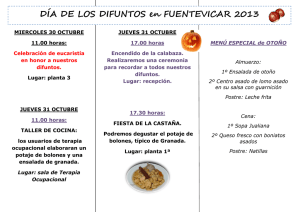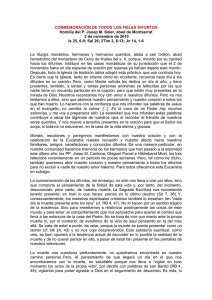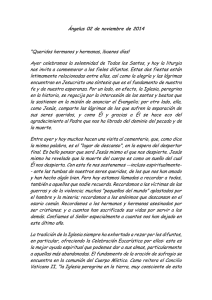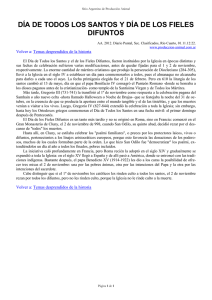The Book of the Names of the Dead
Anuncio
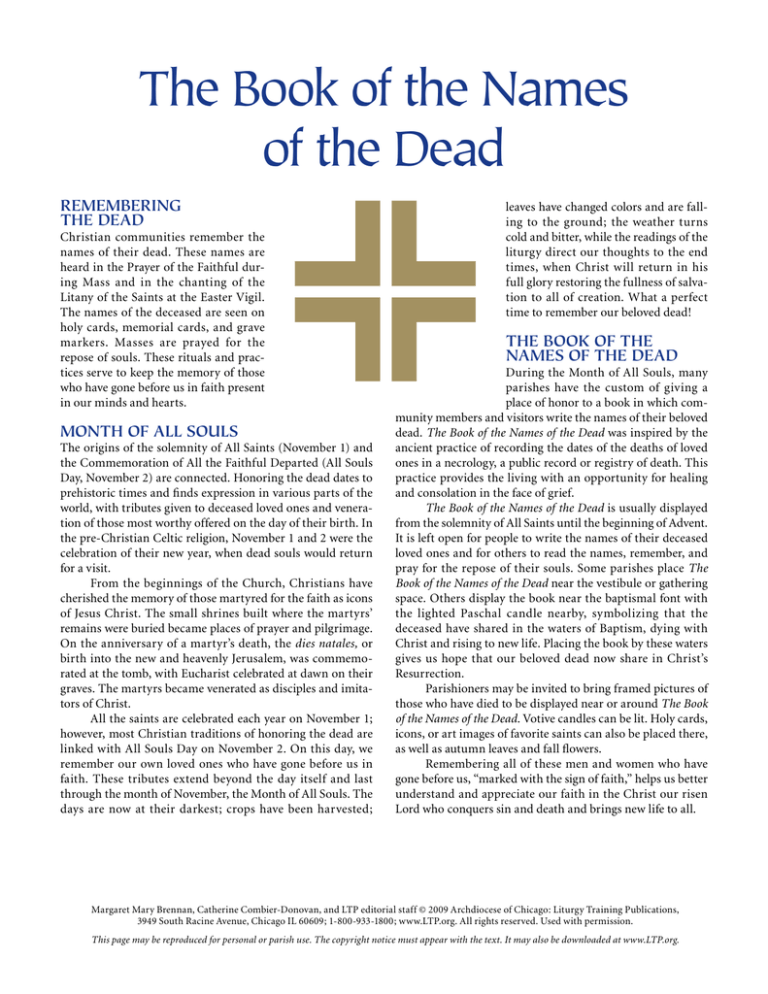
The Book of the Names of the Dead Remembering the Dead Christian communities remember the names of their dead. These names are heard in the Prayer of the Faithful during Mass and in the chanting of the Litany of the Saints at the Easter Vigil. The names of the deceased are seen on holy cards, memorial cards, and grave markers. Masses are prayed for the repose of souls. These rituals and practices serve to keep the memory of those who have gone before us in faith present in our minds and hearts. Month of All Souls The origins of the solemnity of All Saints (November 1) and the Commemoration of All the Faithful Departed (All Souls Day, November 2) are connected. Honoring the dead dates to prehistoric times and finds expression in various parts of the world, with tributes given to deceased loved ones and veneration of those most worthy offered on the day of their birth. In the pre-Christian Celtic religion, November 1 and 2 were the celebration of their new year, when dead souls would return for a visit. From the beginnings of the Church, Christians have cherished the memory of those martyred for the faith as icons of Jesus Christ. The small shrines built where the martyrs’ remains were buried became places of prayer and pilgrimage. On the anniversary of a martyr’s death, the dies natales, or birth into the new and heavenly Jerusalem, was commemorated at the tomb, with Eucharist celebrated at dawn on their graves. The martyrs became venerated as disciples and imitators of Christ. All the saints are celebrated each year on November 1; however, most Christian traditions of honoring the dead are linked with All Souls Day on November 2. On this day, we remember our own loved ones who have gone before us in faith. These tributes extend beyond the day itself and last through the month of November, the Month of All Souls. The days are now at their darkest; crops have been harvested; leaves have changed colors and are falling to the ground; the weather turns cold and bitter, while the readings of the liturgy direct our thoughts to the end times, when Christ will return in his full glory restoring the fullness of salvation to all of creation. What a perfect time to remember our beloved dead! The Book of the Names of the Dead During the Month of All Souls, many parishes have the custom of giving a place of honor to a book in which community members and visitors write the names of their beloved dead. The Book of the Names of the Dead was inspired by the ancient practice of recording the dates of the deaths of loved ones in a necrology, a public record or registry of death. This practice provides the living with an opportunity for healing and consolation in the face of grief. The Book of the Names of the Dead is usually displayed from the solemnity of All Saints until the beginning of Advent. It is left open for people to write the names of their deceased loved ones and for others to read the names, remember, and pray for the repose of their souls. Some parishes place The Book of the Names of the Dead near the vestibule or gathering space. Others display the book near the baptismal font with the lighted Paschal candle nearby, symbolizing that the deceased have shared in the waters of Baptism, dying with Christ and rising to new life. Placing the book by these waters gives us hope that our beloved dead now share in Christ’s Resurrection. Parishioners may be invited to bring framed pictures of those who have died to be displayed near or around The Book of the Names of the Dead. Votive candles can be lit. Holy cards, icons, or art images of favorite saints can also be placed there, as well as autumn leaves and fall flowers. Remembering all of these men and women who have gone before us, “marked with the sign of faith,” helps us better understand and appreciate our faith in the Christ our risen Lord who conquers sin and death and brings new life to all. Margaret Mary Brennan, Catherine Combier-Donovan, and LTP editorial staff © 2009 Archdiocese of Chicago: Liturgy Training Publications, 3949 South Racine Avenue, Chicago IL 60609; 1-800-933-1800; www.LTP.org. All rights reserved. Used with permission. This page may be reproduced for personal or parish use. The copyright notice must appear with the text. It may also be downloaded at www.LTP.org. Libro con los nombres de los difuntos Recordando a los difuntos Las comunidades cristianas recuerdan los nombres de sus difuntos. Estos nombres se pronuncian durante la Oración de los Fieles durante la Misa y se entonan durante la Letanía de los santos durante la Vigilia Pascual. Los nombres de los difuntos se inscriben en tarjetas de oraciones, en recordatorios de funerales y en las lápidas de las tumbas. Se celebran Misas por el eterno descanso de sus almas. Estos ritos y acciones ayudan a mantener presente en nuestra memoria y corazones el recuerdo de quienes nos han precedido en la fe. El mes de Todos los Difuntos Los orígenes de la solemnidad de Todos los Santos (1º de noviembre) y de la conmemoración de Todos los Fieles Difuntos (2 de noviembre) están relacionados entre sí. El honrar a los muertos se remonta a tiempos prehistóricos, con expresiones diferentes en distintas partes del mundo, ofreciendo tributo a los seres queridos fallecidos y venerando a los más dignos el día del aniversario de su nacimiento. La religión precristiana celta celebraba su año nuevo los días 1° y 2 de noviembre, cuando las almas de los difuntos regresaban para visitar a los vivos. Desde los orígenes de la Iglesia, los cristianos han atesorado la memoria de quienes fueron martirizados por su fe como iconos de Jesucristo. Los pequeños santuarios que se construyeron sobre las tumbas de los mártires se convirtieron en lugares de oración y destino de peregrinajes. El día del aniversario de la muerte de un mártir, el dies natalis, el cual celebra el nacimiento del mártir en la Jerusalén nueva y celestial, se conmemoraba junto a su tumba, con la celebración de la Eucaristía al alba sobre la tumba. Los mártires se convirtieron en objeto de veneración como discípulos e imitadores de Cristo. Cada año celebramos a todos los santos el 1º de noviembre. Sin embargo, la mayoría de las tradiciones cristianas que honran a los difuntos están asociadas al Día de Todos los Fieles Difuntos, que se celebra el 2 de noviembre. Ese día recordamos a todos nuestros seres queridos que nos han precedido en esta vida en la fe. Estos tributos van más allá de un solo día y duran todo el mes de noviembre, el mes de Todos los Difuntos. Durante esta época del año los días son más oscuros, la cosecha ha tenido lugar, las hojas de los árboles han cambiado color y están cayéndose, el clima se endurece y enfría, y todo mientras las lecturas litúrgicas dirigen nuestros pensamientos hacia el fin del tiempo, cuando Cristo regresará con toda su gloria para restaurar la plenitud de la salvación para toda la creación. ¡Qué ocasión tan perfecta para recordar a nuestros queridos difuntos! Libro con los nombres de los difuntos Muchas parroquias, durante el mes de Todos los Difuntos, tienen la costumbre de colocar en algún lugar de honor un libro en el que tanto los miembros de la comunidad como los visitantes escriben los nombres de sus seres queridos difuntos. El Libro con los nombres de los difuntos está inspirado en la antigua costumbre de escribir la fecha de la muerte de los seres queridos en una necrológica, un registro público de fallecimientos. Esta práctica ofrece a los que sobreviven a los fallecidos sanación y consuelo durante su sufrimiento y tristeza. El Libro con los nombres de los difuntos se coloca en algún lugar visible a partir del día de la solemnidad de Todos los Santos y se retira al comenzar el Adviento. Durante este tiempo, se deja el libro abierto para que las personas escriban los nombres de sus seres queridos difuntos y para que otros lean los nombres, se acuerden de ellos y oren por el descanso eterno de sus almas. Algunas parroquias colocan el Libro con los nombres de los difuntos cerca del vestíbulo de la iglesia. Otras lo colocan cerca de la pila bautismal, con el cirio pascual prendido a su lado, simbolizando así que los difuntos han compartido las aguas del Bautismo, muriendo con Cristo y renaciendo a una vida nueva. El colocar este libro junto a estas aguas nos da la esperanza de que nuestros seres queridos difuntos comparten ahora en la Resurrección de Cristo. Si se desea, se puede invitar a los feligreses a que traigan fotos enmarcadas de sus seres queridos difuntos y a que las coloquen cerca o alrededor de el Libro con los nombres de los difuntos. Se pueden también prender velas y colocar tarjetas con oraciones, iconos o imágenes de los santos favoritos, así como hojas y flores típicas del otoño. El recordar a estos hombres y mujeres que nos han precedido, “marcados con la señal de la fe”, nos ayuda a entender y apreciar mejor nuestra propia fe en Cristo, nuestro Señor resucitado, quien conquista el pecado y la muerte, y nos trae a todos una vida nueva. Margaret Mary Brennan, Catherine Combier-Donovan y el personal editorial de LTP © 2009 Arquidiócesis de Chicago: Liturgy Training Publications, 3949 South Racine Avenue, Chicago IL 60609; 1-800-933-1800; www.LTP.org. Todos los derechos reservados. Reproducido con los debidos permisos. Sólo se permite la reproducción de estas páginas para uso personal o parroquial. El texto del copyright debe figurar en las copias. Estas páginas se pueden también descargar de www.LTP.org.
